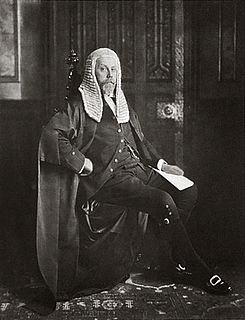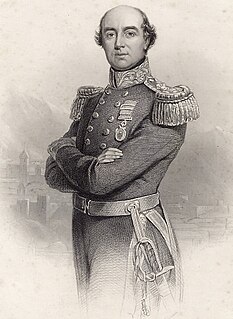Related Research Articles

Viscount Cobham is a title in the Peerage of Great Britain that was created in 1718. Owing to its special remainder, the title has passed through several families. Since 1889, it has been held by members of the Lyttelton family.

Earl Peel is a title in the Peerage of the United Kingdom. The Peel family descends from Robert Peel, eldest son of a wealthy cotton merchant. The family lands, known as Drayton Manor, in the County of Stafford would become more commonly known in modern-day as an amusement park. The family seat is Elmire House, near Ripon, North Yorkshire.

Viscount Ullswater, of Campsea Ashe in the County of Suffolk, is a title in the Peerage of the United Kingdom. It was created in 1921 for James Lowther upon his retirement as Speaker of the House of Commons. He was the eldest son of the Hon. William Lowther, third son of the Hon. Henry Lowther, second son of William Lowther, 1st Earl of Lonsdale. The first Viscount lived to the age of 93, and was pre-deceased by both his eldest son the Hon. Christopher Lowther, a Conservative politician, and his eldest son's eldest son John Arthur Lowther (1910–1942), the title being inherited by his seven-year-old great-grandson, the second and current Viscount, in an extremely rare instance of a great-grandson succeeding his great-grandfather in a peerage. The second Viscount held office in the Conservative administrations of Margaret Thatcher and John Major and since 2003 he has been one of the ninety elected hereditary peers that remain in the House of Lords after the passing of the House of Lords Act 1999.

Viscount De L'Isle, of Penshurst in the County of Kent, is a title in the Peerage of the United Kingdom. It was created in 1956 for William Sidney, 6th Baron de L'Isle and Dudley, VC, KG, GCMG, GCVO (1909–1991).
Baron Hayter, of Chislehurst in the County of Kent, is a title in the Peerage of the United Kingdom. It was created in 1927 for the businessman Sir George Chubb, 1st Baronet. He had already been created a baronet of Newlands in the Baronetage of the United Kingdom in 1900. Chubb was Chairman and Managing Director of the firm Chubb and Sons Lock and Safe Co Ltd, established by his grandfather Charles Chubb in the early 19th century. "Hayter" was the maiden name of George Hayter Chubb's mother, and was selected in preference to "Chubb", as it was not considered appropriate for names of corporations to be attributed to members of the House of Lords. He was succeeded by his son, the second baron. He was Managing Director of Chubb and Sons Lock and Safe Co Ltd. His son, the third baron, was Managing Director and Chairman of Chubb and Sons Lock and Safe Co Ltd and also served as Deputy Chairman of the House of Lords from 1981 to 1995. As of 2014 the titles are held by the latter's son, the fourth baron, who succeeded in 2003.

Baron Brabourne, of Brabourne in the County of Kent, is a title in the Peerage of the United Kingdom. It was created in 1880 for the Liberal politician Edward Knatchbull-Hugessen, the second son of Sir Edward Knatchbull, 9th Baronet, of Mersham Hatch. He had previously represented Sandwich in the House of Commons and served as Under-Secretary of State for Home Affairs and Under-Secretary of State for the Colonies. Lord Brabourne had assumed by Royal licence the additional surname of Hugessen in 1849. His son, the second Baron, represented Rochester in Parliament as a Liberal.
Sir William Hustler (c.1658–1730), of Acklam, Yorkshire, and Little Hatfield, Holderness, Yorkshire was an English draper and Whig politician who sat in the English and British House of Commons between 1695 and 1710. He was a member of the Society for Promoting Christian Knowledge and was great patron of charity schools.
There have been seven baronetcies created for persons with the surname Palmer, two in the Baronetage of England, one each in the Baronetages of Ireland and of Great Britain and three in the Baronetage of the United Kingdom. Four of the creations are extant as of 2015, one of which became merged into the first grantee's later barony: Baron Palmer, the first baron being an heir to part of the Huntley & Palmers international biscuit business and a patron of music. The other current creations were awarded to a lawyer and politician of wealth under Charles II, to a South Sea Company director under George III and to a shipbuilder, shipbroker who was a Liberal statesman under Victoria.
There have been five baronetcies created for people with the surname Napier, three in the Baronetage of England, one in the Baronetage of Nova Scotia and one in the Baronetage of the United Kingdom. As of 2014 two of the creations are extant.
There have been two baronetcies created for persons with the surname Bates, both in the Baronetage of the United Kingdom. As of 2014 both creations are extant.

There have been twenty baronetcies created for persons with the surname Williams, eight in the Baronetage of England, three in the Baronetage of Great Britain and nine in the Baronetage of the United Kingdom. Only five of the creations are extant as of 2017..

There have been four baronetcies created for persons with the surname Miller, two in the Baronetage of England, one in the Baronetage of Great Britain and one in the Baronetage of the United Kingdom. Two of the creations are extant as of 2008.
The Cotts Baronetcy, of Coldharbour Wood in the parish of Rogate in the County of Sussex, is a title in the Baronetage of the United Kingdom. It was created on 15 June 1921 for Sir William Cotts, KBE. He was head of Mitchell Cotts and Co, of London, and of allied companies, merchants, colliery proprietors and steamship owners, and also briefly represented Western Isles in the House of Commons as a National Liberal. The second Baronet assumed by deed poll the additional surname of Mitchell in 1932. He was an actor, writer, journalist, and publisher.
The Esplen Baronetcy, of Hardres Court in Canterbury in the County of Kent, is a title in the Baronetage of the United Kingdom. It was created on 14 July 1921 for Sir John Esplen, KBE,. He was a Senior Director of Esplen, Sons and Swainston, consulting engineers and naval architects, and served as Chief Technical Adviser to the Ministry of Shipping during the First World War.
There have been two baronetcies created for persons with the surname Hodge, both in the Baronetage of the United Kingdom. One creation is extant as of 2010.

The Worsley family is an English family that is derived from Sir Elias de Workesley, a Norman knight who was a youth at the time of the Norman conquest. He later accompanied Duke Robert II of Normandy on the First Crusade and was buried at Rhodes.

Sir Joseph William Isherwood, 1st Baronet was a British naval architect. He invented the Isherwood System of longitudinal construction of ships and the Arcform System.
This is a list of Sheriffs and High Sheriffs of Suffolk.
There have been two baronetcies created, both in the Baronetage of England, for members of the Twysden family of Kent.

Sir Anselm William Edward Guise, 6th Baronet was an English soldier, landowner, and magistrate, of Elmore Court, Gloucester.
References
- ↑ "No. 32558". The London Gazette . 23 December 1921. p. 10486.
- ↑ Debrett's Peerage. 1936.